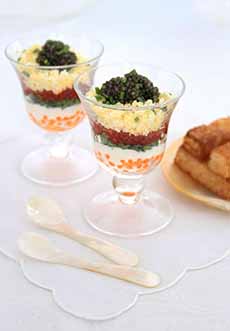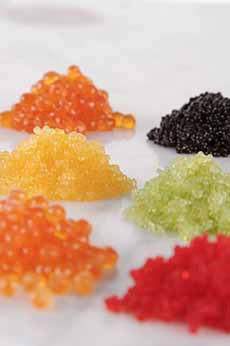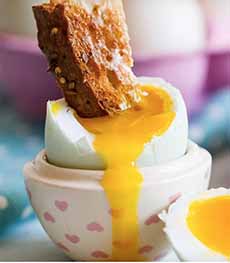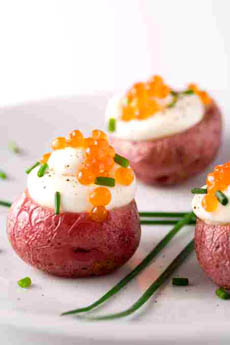Caviar Parfait & More Caviar Recipes For National Caviar Day
|
How about a Caviar Parfait for July 18th, National Caviar Day? Here’s a recipe from California Caviar Company, which sells every type of caviar that makes our heart flutter. > The different types of caviar: a glossary. > See more caviar recipes below. California Caviar made this parfait with three different caviars/roes*: paddlefish sturgeon caviar, trout roe, and saffron-infused whitefish roe. But you can use any type. We made it twice: once with salmon caviar (ikura) and once with flying fish roe (tobiko). Prep time is 30 minutes. 1. HARD-BOIL the eggs. Place them in a pot covered with cold water. Bring to a boil and cook for 5 minutes. Remove from the heat and let them sit in hot water for 10 minutes. 2. TRANSFER the eggs to an ice bath to chill. Once cool, peel the eggs and press them through a sieve with a wooden spatula. 3. MIX 1/4 cup of the crème fraîche with lemon zest and season with salt and pepper. 4. TRIM the crusts from the brioche slices and cut them into four pieces to make the soldiers. In a skillet, melt butter over medium heat and toast brioche sticks until all sides are golden brown. 5. DIVIDE the ingredients evenly among four small parfait cups or aperitif glasses. Layer them starting with trout roe, then crème fraiche, chives, saffron-infused whitefish roe, egg, another teaspoon of crème fraiche, and finally topping with paddlefish. Serve with toasted brioche sticks, a.k.a. toast fingers, or toast soldiers. |
|
|
|
________________ *Caviar vs. roe: Roe are the eggs of a fish. They are also called berries, pearls, and grains. In addition to sturgeon roe, roe from several different species of fish are enjoyed by consumers: keta roe from the keta salmon; masago from the smelt, tobiko from the Icelandic flying fish, avruga from the Spanish herring, plus American roes from the bowfin, lumpfish, paddlefish, trout, and whitefish. In the caviar trade, once the roe has been removed from the fish and salted, it becomes caviar. †“Toast soldiers” is a British term that refers to strips of toast cut from a slice of toasted bread. In the U.S., we call them toast fingers or toast strips. The term “soldiers” arose because the strips are reminiscent of the formation of soldiers on parade. The toast is sliced in this manner so that it can be dipped into the opening of a soft-boiled egg that has had the top of its shell removed (see photo #3). However, it has found many other uses (see these snazzy toast soldiers). The first-known mention of the French term for toast soldiers, mouillettes (moo-YET, dip in English), is in an 1868 novel. The British term, “eggs with soldiers,” appears to date only from the 1960s, first appearing in a novel where it is used to eat soup. In 2005, The Daily Telegraph reported the invention of a device for cutting bread into soldiers. Shaped cutters that turn toast into human-like soldiers are also available [source]. CHECK OUT WHAT’S HAPPENING ON OUR HOME PAGE, THENIBBLE.COM.
|
||






